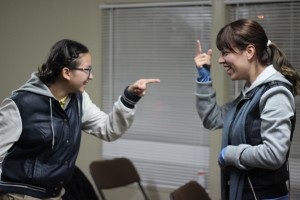
The “deaf” become “Deaf,” proudly capitalizing their culture, hands turn more useful than usual, and smiles remain a universal language—this is the Deaf community. Stereotypically silent, yet loud in truth—and not just metaphorically-speaking.
Deaf culture and the Deaf community
In the Deaf community, sign language suddenly stops being a “cheap substitute” for “real” language; it is a language of its own, with specific grammar and vivid facial expressions. The Deaf meet to share the joy of being part of a rich culture, not as a support group for hearing-impaired people. “They take time out of their lives just to all meet up and show love to each other. That’s what being Deaf is all about,” said freshman Denny Navarro, son of two Deaf parents. Navarro has been fluent in American Sign Language (ASL) since three years-old and is an active member of the Deaf community with his Father.
“Deafies”(term used for Deaf people inside the Deaf community) have traditions and characteristics, such as giving “sign-names” to hearing people (which only a Deaf person can do) and being openly-affectionate from the first time they meet someone. As hearing people walk into the Deaf world, the question will arise: “Are they hearing-impaired, or are we ‘Deaf-impaired?’”
The hearing-minded and their misconceptions
It is common for “hearies” (term used for hearing people in the Deaf community) to see deafness as a disability, but to “Deafies” it certainly is not. “We call ourselves Deaf, not impaired, not deaf and dumb—just Deaf,” said Elvin Garcia, who was born deaf. Garcia believes one misconception about the Deaf is that they cannot speak. “We can do everything else except hear. We are able to vocalize and speak,” he said. “Some like to speak, some don’t. That’s their preference.”
Sign language is not universal. Like other languages, sign comes in different forms, grammar, and “languages.” Therefore, English and ASL are not the same. The public, lacking knowledge about the Deaf community and culture, assume the Deaf want them to “fix” their deafness. However, the majority of Deaf people do not want to “become hearing.” This has been attempted through different methods, such as cochlear implants and speech therapy. “No way [I would get a cochlear implant]. You need to be satisfied with who you are,” said Thalia Hernandez, a “Deafie” who believes the implant could bring about identity problems. Garcia, who uses hearing aids instead, would not get the implant either, mainly due to the side effects and risks (such as emotional instability and mental retardation). Deaf people have fashioned their own culture and identity into existence, and the hearing will not get in the way of that.
Now, knowing that being “deaf” is lacking hearing, but being “Deaf” is being part of a culture, it is easier for the general public to stop seeing deafness as “hearing loss,” but rather “Deaf gain;” losing hearing but gaining a culture.
The hearing and Deaf united
“I feel that the hearing and the Deaf are equal. I mean, hearing is one thing— it doesn’t matter,” said Hernandez. She explained the importance for people to understand “Deafies” have their own way and to be sensitive to their culture. Both Hernandez and Garcia agree that, although there are others ways of communicating (such as pen and paper, lip-reading, cell phone applications), “hearies” should learn at least some signs.
ASL at your fingertips
Timber Creek has an active ASL program in which students are exposed to the language hands-on (literally),the culture, and sense-of-family it inspires. Amanda Robinson, ASL class teacher and club sponsor, graduated from the University of Florida with a degree in communications sciences and disorders. Having no Deaf relatives and being exposed to ASL in her senior year of high school, Robinson gives credit to her childhood neighbor, a sign language interpreter, for sparking her passion for Deaf culture.
Robinson believes it is important for students to attempt to learn ASL. “With 90% of Deaf children being born into hearing families, it’s important that we help bridge the gap between the Deaf and the hearing communities,” she said. Olivia Gray, Sarah Lanshe, Veronica Titus, and Mackenzie Canario, former ASL students of Robinson, are now pursuing interpreting majors.
“From the first day of ASL, students are immersed in the language–they are exposed to a unique learning environment,” said Robinson. “The teacher and the students remain voice-off throughout most of the year.”